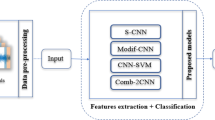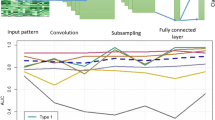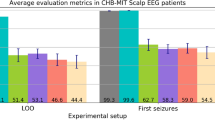Abstract
Predicting seizures before they happen can help prevent them through medication. In this research, first, a total of 22 features were extracted from 5-s segmented EEG signals. Second, tensors were developed as inputs for different deep transfer learning models to find the best model for predicting epileptic seizures. The effect of Pre-ictal state duration was also investigated by selecting four different intervals of 10, 20, 30, and 40 min. Then, nine models were created by combining three ImageNet convolutional networks with three classifiers and were examined for predicting seizures patient-dependently. The Xception convolutional network with a Fully Connected (FC) classifier achieved an average sensitivity of 98.47% and a False Prediction Rate (FPR) of 0.031 h−1 in a 40-min Pre-ictal state for ten patients from the European database. The most promising result of this study was the patient-independent prediction of epileptic seizures; the MobileNet-V2 model with an FC classifier was trained with one patient’s data and tested on six other patients, achieving a sensitivity rate of 98.39% and an FPR of 0.029 h−1 for a 40-min Pre-ictal scheme.





Similar content being viewed by others
References
Aarabi A, He B (2017) Seizure prediction in patients with focal hippocampal epilepsy. Clin Neurophysiol 128(7):1299–1307
Ahmadi A, Soltanian-Zadeh H (2019) Epileptic seizure prediction using spectral entropy-based features of EEG. In: 2019 4th international conference on pattern recognition and image analysis (IPRIA). IEEE
Altunay S, Telatar Z, Erogul O (2010) Epileptic EEG detection using the linear prediction error energy. Expert Syst Appl 37(8):5661–5665
Bandarabadi M et al (2015) Epileptic seizure prediction using relative spectral power features. Clin Neurophysiol 126(2):237–248
Box GEP, Jenkins GM, Reinsel GC (2008) Time series analysis: forecasting and control, 4th edn. Wiley, Hoboken, ISBN 978-0-470-27284-8
Çetin M (2020) Model-based robust suppression of epileptic seizures without sensory measurements. Cogn Neurodyn 14(1):51–67
Chollet F (2017) Xception: deep learning with depthwise separable convolutions. In: Proceedings of the IEEE conference on computer vision and pattern recognition
Daoud H, Bayoumi M (2019) Efficient epileptic seizure prediction based on deep learning. IEEE Trans Biomed Circuits Syst 13(5):804-13
Dissanayake T, Fernando T, Denman S, Sridharan S, Fookes C (2020) Patient-independent epileptic seizure prediction using deep learning models. arXiv preprint. https://arxiv.org/abs/2011.09581
Hastie T, Tibshirani R, Friedman J (2009) The elements of statistical learning: data mining, inference, and prediction. Springer Science & Business Media, Berlin
Hjorth B (1970) EEG analysis based on time domain properties. Electroencephalogr Clin Neurophysiol 29:306–310
Khan H et al (2017) Focal onset seizure prediction using convolutional networks. IEEE Trans Biomed Eng 65(9):2109–2118
Klatt J, Feldwisch-Drentrup H, Ihle M, Navarro V, Neufang M, Teixeira C, Adam C et al (2012) The EPILEPSIAE database: an extensive electroencephalography database of epilepsy patients. Epilepsia 53:1669–1676
Lehnertz K, Mormann F, Osterhage H, Müller A, Prusseit J, Chernihovskyi A, Staniek M, Krug D, Bialonski S, Elger CE (2007) State-of-the-art of seizure prediction. J Clin Neurophysiol 24(2):147–153
Li S, Zhou W, Yuan Q, Liu Y (2013) Seizure prediction using spike rate of intracranial EEG. IEEE Trans Neural Syst Rehabil Eng 21(6):880–6
Litt B, Esteller R, Echauz J, D’Alessandro M, Shor R, Henry T et al (2001) Epileptic seizures may begin hours in advance of clinical onset: a report of five patients. Neuron 30:51–64
Mirowski P, Madhavan D, LeCun Y, Kuzniecky R (2009) Classification of patterns of EEG synchronization for seizure prediction. Clin Neurophysiol 120(11):1927–1940
Mormann F, Lehnertz K, David P, Elger CE (2000) Mean phase coherence as a measure for phase synchronization and its application to the EEG of epilepsy patients. Physica D 144(3–4):358–369
Mormann F, Kreuz T, Rieke C, Andrzejak RG, Kraskov A, David P et al (2005) On the predictability of epileptic seizures. Clin Neurophysiol 116:569–587
Petrosian A, Prokhorov D, Homan R, Dasheiff R, Wunsch D (2000) Recurrent neural network based prediction of epileptic seizures in intra- and extracranial EEG. Neurocomputing 30:201–218
Piryonesi SM, El-Diraby TE (2020) Data analytics in asset management: cost-effective prediction of the pavement condition index. J Infrastruct Syst 26(1):04019036
Rajdev P, Ward M, Rickus J, Worth R, Irazoqui P (2010) Realtime seizures prediction from local field potentials using an adaptive Wiener algorithm. Comput Biol Med 40(1):97–108
Rasekhi J et al (2013) Preprocessing effects of 22 linear univariate features on the performance of seizure prediction methods. J Neurosci Methods 217(1–2):9–16
Sandler M, Howard A, Zhu M, Zhmoginov A, Chen L-C (2018) Mobilenetv2: inverted residuals and linear bottlenecks. In: Proceedings of the IEEE conference on computer vision and pattern recognition. pp 4510–4520
Shahbazi M, Aghajan H (2018) A generalizable model for seizure prediction based on deep learning using CNN-LSTM architecture. In: 2018 IEEE global conference on signal and information processing (GlobalSIP). IEEE
Tan M, Le QV (2019) Efficientnet: rethinking model scaling for convolutional neural networks. arXiv preprint. https://arxiv.org/abs/1905.11946
Truong ND et al (2018) Convolutional neural networks for seizure prediction using intracranial and scalp electroencephalogram. Neural Netw 105:104–111
Tsiouris KM, Pezoulas VC, Koutsouris DD, Zervakis M, Fotiadis DI (2017) Discrimination of pre-ictal and interictal brain states from long-term EEG data. In: 2017 IEEE 30th international symposium on computer-based medical systems (CBMS). IEEE, pp 318–323
Zhang Z, Parhi KK (2016) Low-complexity seizure prediction from iEEG/sEEG using spectral power and ratios of spectral power. IEEE Trans Biomed Circuits Syst 10(3):693–706
Acknowledgements
This study was carried out following a previous project in the Babol Noshirvani University of Technology, and used the same limited dataset involving EEG features collected under FP7 Epilepsia Project, and made available to Dr. Rasekhi through a researcher visit opportunity to the Department of Informatics in the University of Coimbra, Portugal. Again, we thank Professor António Dourado and Dr. C.A. Teixeira from UC for their essential support and priceless contribution. Thanks also go to Google to provide GPU access at ‘colab.research.google.com’ that made it possible to run the related programs.
Author information
Authors and Affiliations
Corresponding author
Additional information
Publisher's Note
Springer Nature remains neutral with regard to jurisdictional claims in published maps and institutional affiliations.
Rights and permissions
About this article
Cite this article
Sarvi Zargar, B., Karami Mollaei, M.R., Ebrahimi, F. et al. Generalizable epileptic seizures prediction based on deep transfer learning. Cogn Neurodyn 17, 119–131 (2023). https://doi.org/10.1007/s11571-022-09809-y
Received:
Revised:
Accepted:
Published:
Issue Date:
DOI: https://doi.org/10.1007/s11571-022-09809-y




